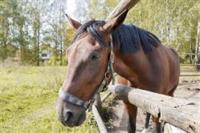Equine Herpesvirus: Management Procedures, Control, and Prevention

In 2011, after attending a cutting horse national championship in Utah, horses from multiple states were observed exhibiting neurologic signs of infection. It was quickly determined that the affected animals had contracted a form of equine herpesvirus, the highly contagious and fast spreading virus that causes respiratory and neurologic disease, and abortions in pregnant mares.
Spread of EHV
Since the 2011 outbreak, cases of equine herpesvirus have continued to spread. Documented cases have been noted in each of the following states:
- Colorado
- Florida
- Illinois
- Michigan
- Minnesota
- New Jersey
- Ohio
- Oregon
- Pennsylvania
- Tennessee
- Texas
- Virginia
EHV in 2015
Equine Disease Quarterly reports that in the United States, in the first quarter of 2015, further cases of equine herpesvirus (EHV) related diseases have been confirmed and recorded with respiratory disease, abortion fetal and neonatal death, and neurologic disease. These cases are related to the strains of equine herpesvirus-1, -2, -3, -4, and -5.
Management of EHV
Disease outbreaks of EHV tend to be associated when groups of horses are gathered for equine-related events. Stressors, such as travel and housing in unfamiliar environments, can create conditions for the virus to re-surface in horses who are latent carriers of EHV, and the most common form of transmission of the virus comes from horse-to-horse contact. Management is key to containing the spread of disease.
In an effort to avoid future contamination, horses that are known to be uninfected need to be protected. A management plan should be established to provide the following:
- Screen any horses when first brought on to property
- Isolate new horses for 2 to 3 weeks and monitor for any clinical signs of EHV
- Avoid contact of new healthy animals with those that may be immunosuppressed
- Locate mares away from any other horses
- Minimize additional stressors such as crowding, parasites, and poor nutrition
- Monitor the temperature of new horses daily to identify any fever spikes
- Work with healthy horses only after following a washing and disinfecting regimen for hands, clothing, shoes, grooming equipment, and tack
- Avoid the use of communal watering and feeding tubs
EHV Infection Control
When the diagnosis of EHV is determined, the following steps need to be followed:
- Isolate infected horse
- Quarantine for 3 weeks after all clinical signs subside
- Establish a sanitizing regimen for people handling infected horses, including:
- Hand washing after handling each horse
- Shoe disinfectant
- Changing clothes before working with uninfected horses
- Disinfect the environment
- Virus can live for several weeks in the environment, but can be killed by common disinfectants such as a bleach/water mix
- Disinfect any part of the environment that may have come into contact with shed virus particles, for example:
- Stalls
- Aisles
- Remove stall bedding and burn
- Disinfect any equipment used on or near infected horse, such as:
- All stable equipment
- Grooming tools
- Tack, blankets
- Water and feed containers
Immunity and Protection
An established vaccine protocol can help to keep horse herds healthy and diminish the likelihood for disease outbreak. Offered in both inactivated and modified live virus form, the determination for the need of the vaccine is dependent upon the individual animal, as some are more susceptible to the virus, for example:
- Foals, weanlings, and yearlings
- Horses less than 5 years of age
- Performance horses in high-risk areas such as race tracks
- Horses that are housed in areas where horses are moved on and off premises such as breeding farms or those who come into contact with pregnant mares
- Broodmares
- Breeding stallions
According to the American Association of Equine Practitioners (AAEP), there are many points that need to be taken into consideration regarding the proper use of vaccines to fight the strains of equine herpesvirus. Descriptions, guidelines benefits, and concerns for use of the vaccines are noted by the American Association of Equine Practitioners and can be found at www.aaep.org/-i-173.html.
If you need to know more information about equine herpesvirus, please contact your Covetrus Veterinary Representative today at 855.724.3461.
Information gathered from:
http://www.thehorse.com/articles/36118/international-equine-disease-report-first-quarter-20155
www.aaep.org/-i-173.html
http://www.vet.k-state.edu/vhc/services/equine/timely-topics/Equine_herpesvirus_2015.html
http://www2.ca.uky.edu/gluck/biblioehv1.asp
Careers
Are you looking for a place to let your talents shine? At Covetrus, we help our practitioner customers better serve their patients and take pride in providing the best customer experience possible. Search our open positions to see our available opportunities.
Newsletter
Stay current with what’s going on with Covetrus, subscribe to receive our newsletter and email communications. Subscribers will receive the latest information in practice management, sales and marketing, animal health, and more.


Leave a comment